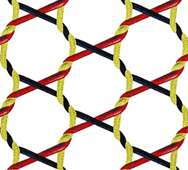Bobbinet

The Bobbinet machine is a lacemaking machine invented and patented by John Heathcoat in 1808 (patent no. 3151), and with a slight modification it was patented again in 1809 (patent no. 3216). It was then also known as the Old Loughborough. Bobbinet tulle or genuine tulle is a specific type of tulle which has been made in the United Kingdom since the invention of the bobbinet machine . Heathcoat coined the term "bobbin net", or bobbinet as it is spelled today, to distinguish his machine-made tulle from the handmade "pillow lace". Pillow lace, called so because of the pillow used to produce handmade bobbin lace. Machines based on his original designs are still in operation today producing fabrics in Perry Street, Chard, Somerset, UK.
History
The forerunner of bobbinet tulle was bobbin lace. Lace has been produced for a long time, made in tedious hand labour with thin thread and needles or bobbins. Bobbin lace is made by weaving the threads by moving the bobbins over or under each other. Much bobbin lace is based on a net ground. By the end of the 18th century, people tried to produce the net ground mechanically. In 1765 they managed to create a tulle-like fabric on a so-called stocking framework. It took, however, some more years until the first real tulle could be produced mechanically. Bobbinet machines were finally invented in 1808 by John Heathcoat. He studied the hand movements of a Northamptonshire manual lace maker and reproduced them in the roller-locker machine. The 1809 version of this machine (patent no.3216) became known as the Old Loughborough, it was 18 inches (46 cm) wide and was designed for use with cotton. [1]
The smooth, unpatterned tulle produced on these machines was on a par with real, handmade lace net. Heathcoat’s bobbinet machine is so ingeniously designed that the ones used today have suffered little alteration.
Fabric structure
Bobbinet tulle is constructed by warp and weft yarns in which the weft yarn is looped diagonally around the vertical warp yarn to form a hexagonal mesh which is regular and clearly defined. Bobbinet netting has a characteristic diagonal fabric appearance, is diagonally stable and slideproof, durable, sheer, the lightest bobbinet weighing no more than 6 g per m2 and has a high strength to weight ratio.
Uses
Bobbinet tulle fabrics have long been used for high-quality exclusive curtains, bridalwear, haute couture fashion, lingerie, embroidery, where it is used as base cloth for the actual embroidery, and as base nets for high-quality wigs. Use has also extended into technical applications where the material's properties are more important than its appearance. These technical applications include sunblinds for cars and railway coaches, safety nets, parachute skirting, radar reflective fabrics for military decoys, flexible textile switches and sensor, as well as light control fabrics for the film and theatre industries.[2] Depending on the yarns bobbinet tulle is produced with, it can, for example, be made to be almost invisible against the skin or even conductive.
References
- ↑ Earnshaw, Pat (1986). Lace Machines and Machine Laces. p. 67. ISBN 0 7134 4684 6.
- ↑ "Swiss Tulle, manufacturer of Bobbinet".
